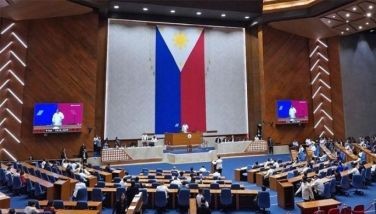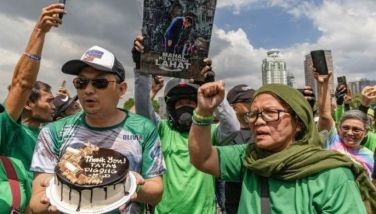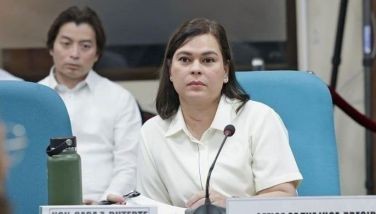Pack-up time for Eddie Romero, 88
MANILA, Philippines - Just as he did in his dozens of movies, National Artist Eddie Romero kept his friends guessing until the very end on the state of his health, catching most everybody by surprise when he “packed up†last Tuesday afternoon at the St. Luke’s Medical Center.
He would have turned 88 on July 7.
“Even I didn’t expect him to go that fast,†Eddie’s only son Joey, also a director, with widow the former Carolina Gonzales, 90, told The STAR in a phone interview yesterday. “He was acting normal until recently.â€
Joey, a member of the MTRCB (Movie & Television Review and Classification Board), revealed that his father was diagnosed with prostate cancer more than a year ago, something which many of those in the industry were not aware of.
“He was under treatment,†added Joey, “but it didn’t stop him from doing his usual chores.â€
That is, until the cancer metastasized to his bones and lungs so he had to be hospitalized, initially for two weeks. He was released after four days but had to be brought back on May 23. He then developed pneumonia.
Five days later, he died after briefly slipping into a coma.
The National Commission for Culture and the Arts said the film director, producer and writer died due to a blood clot on the left side of his brain.
Meanwhile, Malacañang mourned yesterday the passing of Romero, who was named National Artist for film and broadcast arts in 2003.
“His aesthetic was delivered in a simple style, but never empty; always calculated, precise and functional, but never predictable,†deputy presidential spokesperson Abigail Valte said.
Romero’s work spanned generations and influenced filmmakers both here and abroad.
He was the second National Artist from Silliman University, after poet Edith Tiempo, who died in 2011.
“Usually,†recalled Joey, “we would go out for dinner every Sunday and make kuwento-kuwento about movies. But last Sunday, he was too weak to get out of bed, so I whispered to him, ‘Dad, we can’t have our usual dinner tonight’.â€
Edgar Sinco Romero was born on July 7, 1924 in Dumaguete. He studied at Silliman University, which issued the following statement “in honor of an outstanding Sillimanian,†signed by Ben Malayang III, the school president: “Silliman University mourns the death of National Artist for Film Eddie S. Romero. He was a beloved alumnus, an Outstanding Sillimanian, and friend to many of us. “Mr. Romero was a source of inspiration and pride of the Silliman community for his immense contributions to shaping a strong Filipino identity. His films captured the resilience of the Filipino. He brought to the consciousness of one and all the continuing need for a sense of patriotism and love of country. His works built a bridge between a rich past to the continuing struggles of today, and provided a glimpse into what more this country can become. Indeed, his passion for the arts, particularly filmmaking, echoed a timeless and tireless commitment to believing in the greatness of the Filipino nation.
“In recognition of a life embodying competence, character and faith, Silliman University honored Mr. Romero with the Outstanding Sillimanian Award in the field of Arts and Filmmaking in 1996. “Mr. Romero obtained his Elementary and High School diplomas from the University in 1936 and 1940, respectively.
“The entire Silliman community expresses our deepest sympathies to the family and loved ones of Mr. Romero. We join the country in prayer.â€
A prolific writer and director, Romero left behind a body of work that spans more than 60 years, including such classics as “Agila†starring Fernando Poe Jr.; “Ganito Kami Noon, Paano Kayo Ngayon†(1976) with Christopher de Leon and Gloria Diaz; “Manila, Open City†(1968) and “Banta ng Kahapon†(1977), “Kamakalawa†(1981), plus made-for-Hollywood movies like “The Passionate Strangers†(1966), “Black Mama, White Mama†(1972) and “Savage Sisters†(1974).
His last film was “Faces of Love†in 2006.
The NCCA said at age 12, Romero wanted to become a writer and published his first short story.
National Artist for film Gerardo de Leon took notice of his writings and invited him to write for the movies, paving the way for Romero to work in the movie industry. Writing for films eventually led to directing and producing.
His films are noted for their simplicity, ambition and originality. Aside from making films, Romero worked tirelessly to promote Philippine arts and culture.
He was a member of the Cinema Evaluation Board, under the Film Development Council, which grades local films to determine if they are worthy of tax rebates.
He was active with the NCCA, serving as chairman of its Cinema Values Reorientation Program and head of the National Committee on Cinema and supporting its programs.
He donated the rights of his most famous film “Ganito Kami Noon...Paano Kayo Ngayon†to the institution.
Besides his wife Carolina and son Joey, Romero is also survived by two sons – “my half-brothers,†said Joey.
“Their mom is (actress) Mila del Sol. One of them is coming home from the States for our dad’s wake.â€
Romero’s remains lie at the Mt. Carmel Chapels on Broadway Street in Quezon City. A necrological service will be held at the Cultural Center of the Philippines on Sunday, June 2, after which the body will be interred at the Libingan ng Mga Bayani. – With Aurea Calica
- Latest



























